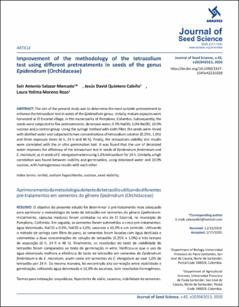Optimization of the tetrazolium test in three species of orchids of the Andean forest
...
SALAZAR MERCADO, SEIR ANTONIO | 2020-05
In order to improve the cultivation and conservation of orchid species, it is important to assess the physiological quality of orchid seeds. One of the most traditional tests for analysing seed quality is the tetrazolium test, whose effectiveness is known to improve with pre-treatment of the seeds. As a result, this study compared various pre-treatments to determine how efficient they were at optimising the tetrazolium test in seeds belonging to Cyrtochilum aemulun, Elleanthus aurantiacus and Lephantes sp. The experiment was based on five different pre-treatment solutions, after which the seeds were exposed to tetrazolium at two different concentrations and for three different exposure times. First, the seeds were soaked for ten minutes in one of five pre-treatment solutions: chlorine 0.5%, chlorine 1%, deionised water, sucrose solution 10% (w/v) or a control in which no pre-treatment was applied. After pre-treatment, the seeds were soaked in the dark in a tetrazolium solution, either at 0.25% concentration or at 1.0% concentration, and for either 6, 24 or 48 hours. The control seeds exposed to no pre-treatment showed an increase in the viability of Lephantes sp. at significant difference from the pre-treated seeds. Similarly, pre-treatment with 10% sucrose produced an increase in the tetrazolium test’s effectiveness in E.aurantiacus seeds, with significant differences from the control in most treatments. Therefore, the use of sucrose as a pre-treatment is recommended, in addition to increasing the concentration and exposure time of the seeds.
LEER











